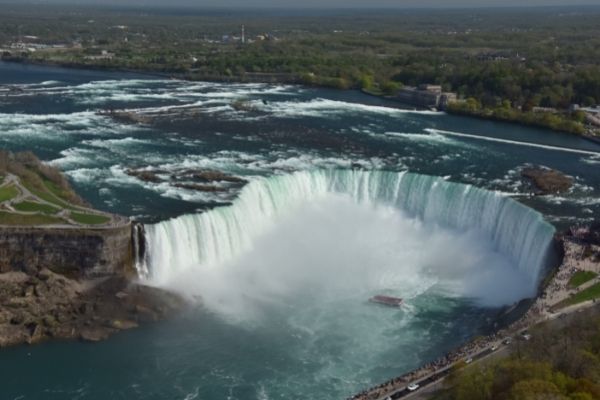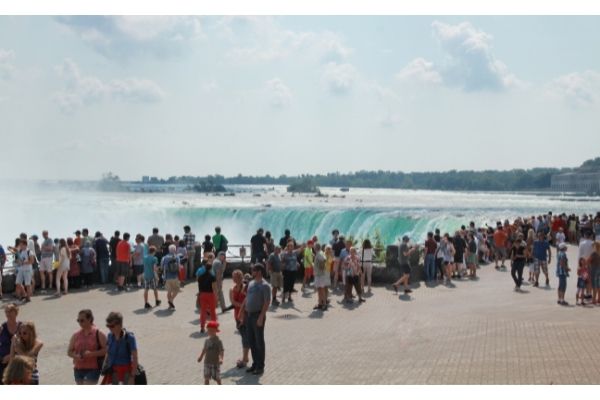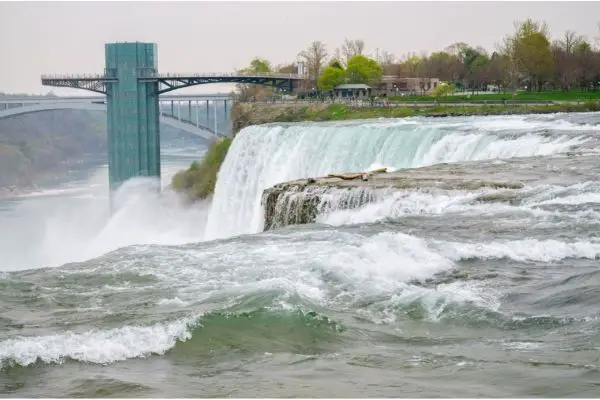Niagara Falls is one of the top tourist destinations in both the USA and Canada. It is situated at the border of the USA and Canada. We have gathered a complete set of Niagara Falls Facts that will help you in learning all about Niagara Falls. You are going to learn about its location, the number of waterfalls, its map, description, why it is famous, its tourism, visiting hours, its height, depth, water source, history, importance and many other Interesting Facts About Niagara Falls.
The Niagara Falls Facts
What Is The Niagara Falls- Niagara Falls Introduction
- The Niagara falls is a group of three waterfalls on the Niagara River in the northeastern region of North America.
- The waterfalls are located on the southern end of the Niagara Gorge (canyon carved by the Niagara River), extending between the American state of New York and the Canadian province of Ontario.
- Unlike most of the tall waterfalls in the world, an enormous amount of water flows over Niagara Falls, which makes it more impressive.
- The waterfalls are one of the most famous tourist attractions of the North American continent.
How Many Waterfalls Are In Niagara Falls?
There are three waterfalls in Niagara Falls. These are:
- Horseshoe Falls or Canadian Falls
- The American Falls
- The Bridal Veil Falls
Where Is The Niagara Falls Located – Niagara Falls Location
- Niagara Falls is located in the North American continent.
- It spans between the border of Canada and the United States.
- Its exact location is 17 miles (27 km) northwest of Buffalo city (New York) and 75 miles (121 km) south southeast of the Canadian capital city, Toronto.
Is Niagara Falls In Canada Or The USA?
- Niagara Falls is a group of three waterfalls that are located at the border region between Canada and the USA.
- The largest waterfall, the Horseshoe Falls, lies in Canada while the other two small falls (the American Falls and the Bridal Veil Falls) lie in the USA.
Niagara Falls Map Of Canada

Niagara Falls Description
- Niagara Falls is a group of three waterfalls in the Niagara River.
- It is located at the international border between the USA and Canada.
- Goat Island separates the large Horseshoe Falls and the small Bridal Veil Falls. While Luna Island separates the Bridal Veil Falls from the American Falls.
- The height of Niagara Falls is about 187 feet (57 meters). The American Falls is between 69 and 98 feet (21 and 30 meters) high due to the presence of large boulder stones at its base. Its total vertical drop from the top of the falls to the river is up to 188 feet (57 meters). The total height of the Bridal Veil Falls is up to 181 feet (55 meters).
- The width of the large Horseshoe Falls is up to 2,590 feet (790 meters), of the American Falls, is up to 1,050 feet (320 meters), and of the Bridal Veil Falls is only 56 feet (17 meters).
- The combined flow rate of Niagara Falls is 168,000 m³ (six million cubic feet) per minute during peak daytime tourist hours.
What Is Niagara Falls Known For
- Niagara Falls is known for being:
- A geological wonder
- The most powerful waterfalls in the North American Continent with the highest flow rate
- A spectacular site
How Tall Is The Niagara Falls – Niagara Falls Height – Niagara Falls Height In Feet
The heights of Niagara Falls are shown in the following table:
| S.No | Name | Height (meters and Feet) |
| 1 | The Horseshoe Falls or Canadian Falls | 51 m (167 feet) (from the top of the falls to the river) |
| 2 | The American Falls | 21 to 34 m (70 to 110 feet) (from top to rock pile) 57 m (188 feet) from top to the river |
| 3 | The Bridal Veil Falls | 24 m (78 feet) (from the top of the fall to the top of the rock pile) 55 m (181 feet) (from the top of the fall to the river) |
How Deep Is The Niagara Falls – Niagara Falls Depth
- Below Niagara Falls, the depth of the water is 170 feet.
- This depth is around equal to the height of the Niagara Gorge banks.
Where Niagara Falls Water Come From
- The water flowing over Niagara Falls comes from four of the Great Lakes, which are the Superior, Michigan, Huron, and Erie.
- After passing over Niagara Falls, the water flows down the Niagara River and makes its way to Lake Ontario.
- From Lake Ontario, the water then flows to the St. Lawrence River from where it finally flows to the Atlantic Ocean.

How Old Is The Niagara Falls
- Irving H. Tesmer and Jerold C. Bastedo describe in their book (Colossal Cataract: The Geologic History Of Niagara Falls) that the features that became Niagara Falls were formed around 10,000 years ago.
- According to another source, the formation of Niagara Falls started more than 12,000 years ago at the end of the Ice Age.
The History Of Niagara Falls – Niagara Falls History
- Around 10,000 years ago, the Wisconsin Glacial Episode (the glacial period of North America that is considered as the most recent) created the features that later become the Niagara Falls.
- When the ice sheets retreated northward, it left behind a huge quantity of melted water. The melted water accumulated in the basins that were carved by the glaciers and so the Great Lakes we know today has been created.
- The melting of ice caused the draining of the upper Great Lakes into the Niagara River, which followed the naturally altered topography over the Niagara Escarpment.
- The river eventually carved a gorge or canyon through the north-facing cliff.
- The interactions of the three major rock formations caused uneven erosion of the rocky bed.
- The erosion of the upper hard stone layer (caprock formation) was slow as compared to the underlying materials.
- Just beneath the caprock lies the softer and weaker sloping Rochester Formation, which is mainly composed of shale with some thin layers of limestone.
- The third formation is the Queenston Formation that is submerged in the river and is composed of shale and sandstone.
- The river ultimately eroded the soft layers that held up the hard layers causing the undercutting of the hard caprock, which broke into great pieces.
- Countless repetitions of this process ultimately carved out the falls.
- Around 10,900 years ago, the location of Niagara Falls was between the present-day Lewiston (New York) and Queenston (Ontario). However, the falls retreated about 10.9 km (6.8 miles) toward the South due to the erosion of the crest.
- Erosion also changed the shape of the Horseshoe Falls from a small arch to a horseshoe shape bend, and then to the current V-shape.
- The historic average rate of erosion was 3 feet (0.91 m) per year, which has been slowed through engineering to a current rate of about 1 foot (30 cm) per year.
Why Niagara Falls Is Important
Niagara Falls is important because:
- It is one of the world’s most famous waterfalls and geological wonders.
- The region where it is located has a special historical association with Native Americans, early exploration of the Europeans in North America, and the Underground Railroad.
- It also has a close historical association with the American Revolution, the French and Indian War, and the War of 1812.
- For a long time, the Falls have been a major source of hydroelectric power and an important site for ancillary industries.
- Its height and the amount of water flowing over makes it a well-known tourism site for over 200 years.
- All these features make it a national landmark and a symbol of the American conservation movement.
What Type Of Waterfall Is Niagara Falls
- Niagara Falls is a cataract type of waterfall.

Niagara Falls Hydropower
- The flow of water over the falls with enormous power has long been recognized as a potential energy source.
- Daniel Joncaire was the first known person who made the effort to make use of the water of the falls. In 1750, he constructed a small canal above the falls to provide power for his sawmill.
- In 1805, Augustus and Peter Porter bought this region including both the American Falls from the government of the New York State. They enlarged the original canal and supplied hydraulic power to their tannery and gristmill.
- The Niagara Falls Hydraulic Power and Mining Company were chartered in 1853, which then built the canals to use the enormous power of the falls for the generation of electricity.
- Under the leadership of Jacob F. Schoellkopf, the first hydroelectric generating station was constructed on the Niagara River in 1881, which generated DC (direct current) electricity.
- By 1896, financing from several tycoons made it possible to build giant underground channels leading to turbines. It generated more than 100,000 horsepower (75 MW).
- On the Canadian side, several private companies also started to make use of the energy of the falls. In 1906, the Government of Ontario then took control of the power transmission operations and supplied Niagara’s energy to many parts of the province.
- In 1957, the construction of Robert Moses power plants was started to replace the old and partially destroyed Schoellkopf power stations. It has a power generating capacity of 2.5 GW.
- On the Canadian side, Sir Adam Beck’s (Ⅰ and Ⅱ) power stations were built in 1922 and 1954 respectively. The power generating capacity of both stations is 1,997 MW (2,678,000 hp).
Niagara Falls Tourism
- Niagara Falls is a great tourism site.
- The average number of visitors that visit Niagara Falls annually is up to 8 million.
- In 2017, a total of 12.95 million tourists visited Niagara Falls.
- Of the total tourists, 67.1% were Canadian, 24.5% were American, while 8.4% were overseas.
- In 2017, the total tourism expenditure was $2.4 billion.
Niagara Falls Visiting Hours – Niagara Falls Visit Best Time
- Summer is the best season to visit Niagara Falls. May to September is the peak season.
- The best time to visit Niagara Falls is in the early morning or late afternoon.
- The visiting hours are:
| Months | Visiting Hours |
| From September to October | 8:00 AM to 5:00 PM at Sunday to Friday 8:00 AM to 6:00 PM on Saturday |
| From October to March | 8:00 AM to 5:00 PM |
| On 24 December | 8:00 AM to 3:00 PM |
Swimming In Niagara Falls
- Swimming in Niagara Falls is extremely dangerous and life-threatening.
- The large Horseshoe Fall is 51 meters tall and water rushes at the speed of about 109 km/h over its edges.
- If someone wants to swim in Niagara Falls, he/she would find himself hurtling in cold water at the speed of 109 km/h towards the edge.
- After a 51 meter drop from the edge, he/she would face swirling water all around him at the bottom that could easily cause suffocation.
- The pools and creeks of the park have calm and clear water in spring and summer, where people swim. However, lifeguards there always stay alert to make sure that swimmers are safe.
Has Anyone Ever Died At Niagara Falls
- Statistics show that an estimated number of about 5,000 people were found dead in the Niagara River between 1850 and 2011.
- The average number of people who die flowing over the falls each year is between 20 and 30.
- Most of the deaths are suicides. The majority of these suicides occur from the largest Canadian Horseshoe Falls.
- Officials do not publicize most of these suicides.
Niagara Falls Fun Facts
- Niagara Falls is not the highest waterfall in the world. Around 500 other waterfalls are found in the world that is higher than Niagara Falls.
- The combined flow rate of the three waterfalls of Niagara Falls is the highest of any waterfall in North America.
- By flow rate, the Horseshoe Falls is the most powerful waterfall in the North American Continent. Its recorded peak flow rate was 6,400 m³ (230,000 cubic feet) per second.
- The amount of water flowing every second over Niagara Falls is about 3,160 tons.
- The speed of water flowing above the falls reaches a maximum of 40 km/h (25 mph). At the falls, the speed becomes as fast as 109 km/h (68 mph). Below the falls, the speed of water then becomes 48 km/h (30 mph).
- Niagara Falls retreated about 6.8 miles from its original location in a period of 10,000 to 12,500 years.
- Electricity was first sold as a product from the Niagara Gorge Discovery Center (situated above the Schoellkopf Power Station).
- In New York State, Niagara is still the greatest power producer, which has a power generating capacity of 2.5 GW.
- Annie Edson Taylor, a 63 years old school teacher, was the first person to successfully survive while going over Niagara Falls in a wooden barrel. Her adventure was a publicity stunt but she never earned much money.
- Niagara Falls State Park was established in 1885. It is the oldest state park in the USA that is explored by more than 8 million visitors each year.


